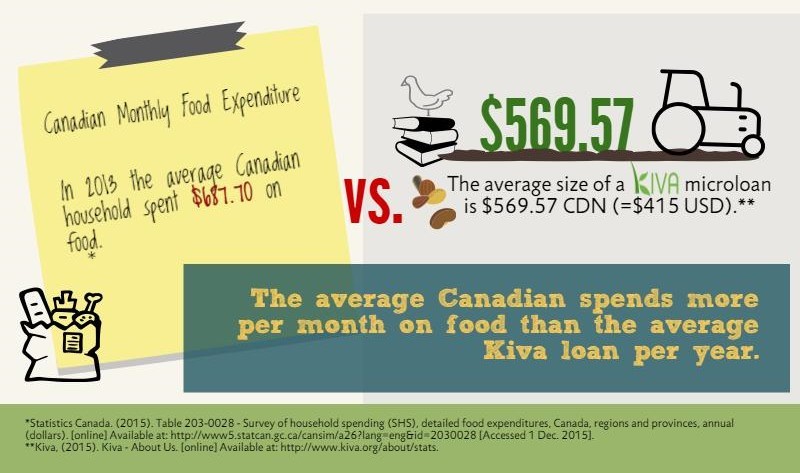Helping others with microfinanced loans
it’s the season of giving and there are various non-profit organizations seeking donations, volunteers and financial support such as local food bank, Red Cross, World Vision, and Gifts of Hope. These organizations are looking for support all year round! One option that doesn’t receive much attention is microfinancing.
Microfinancing assists those who don’t have bank and loan services. Funding is often provided to low-income individuals who need the assistance to continue and grow their business. Where traditional loans are not available, micro-loans can help provide individuals or groups with the necessary funds to improve their business and out of poverty.
 Not everyone is fortunate enough to have access to financial services. In many developing countries the bank rate (lending interest rate) ranges from 8% to 30% (Canada’s ≈2.7%). Besides high rates, assets or collateral are required to secure traditional loans. Without any or enough assets/collateral, traditional financing won’t be provided despite the small loan size. Those who do qualify for tradition loans face high interest rates. High interest rates in developed countries make it very difficult for persons to overcome the disadvantages of having little cash, technology, markets and resources.
Not everyone is fortunate enough to have access to financial services. In many developing countries the bank rate (lending interest rate) ranges from 8% to 30% (Canada’s ≈2.7%). Besides high rates, assets or collateral are required to secure traditional loans. Without any or enough assets/collateral, traditional financing won’t be provided despite the small loan size. Those who do qualify for tradition loans face high interest rates. High interest rates in developed countries make it very difficult for persons to overcome the disadvantages of having little cash, technology, markets and resources.
One example of a microfinancing program is Kiva. Since 2005 Kiva has offered microfinancing across five continents to those without access to traditional banking services. Persons loan as little, or as much, as they wish through a collective funding process to finance loans. Kiva’s collected loan then goes to ‘field partners’ who administer the loan, and the trustee of the loan later repays. Once it is repaid, the original lender can re-use the funds for another Kiva trustee loan.
Typically field partners are located in disadvantaged and marginalized areas, offering a necessary service of small loans (Kiva average loan is $415 USD) where traditional loans are not easily offered or are difficult to repay. ‘Field partners’ borrow from Kiva at 0% interest, which lowers their risk in the case of default. By reducing the risk for field partners, they can expand their lending program to include new and marginalized borrowers who would likely be turned away from traditional state financing. Without Kiva’s crowdfunded loans, these field partners would not be able to provide these loans. After 10 years the Kiva micro-loan model has created opportunities for thousands of persons across the world. Nearly 1 million loans have been made so far, with a 98.45% success of repayment.
Individuals who offer funds for microfinancing get the opportunity to select the person(s) and project(s) they wish to fund. Kiva wants to ensure finances are well protected. They suggest lenders diversify portfolios and lend to multiple projects rather than allotting all funds to one single project. Since these are loans, there still is a risk of default, currently only a 1.3% risk. Kiva also wants to be transparent, so they provide profiles of each field partner, listing their strengths, the risk of working with them and their rates of delinquency and default.
Kiva and other microfinancing offer a gift which is worth giving, it’s the opportunity that many of us already have and take for granted. Most of us can secure a loan to buy new items but imagine not having the finances needed to buy seed or equipment to produce our food or livelihood.
This holiday season Stuart and I this season have chosen this season to contribute to Kiva’s microfinancing. Although there are a number of loans (5900+) to choose from, we decided to start our Kiva experience by each lending to someone(s) seeking loans for their farming ventures.
The first loan we chose is a group of women farmers in the Teso District of Kenya, who are seeking a $925 USD loan for maize seed and fertilizer through the One Acre Fund. ![]()
The other loan we made was towards a $400 USD loan to a young El Salvador farmer. This loan is also a matched loan, for every $25 provided, corporate sponsors will match with an additional $25.
If you have the time please check out both these loan trustee’s stories, and perhaps you too will find the funds to help these or others seeking microfinancing this holiday season.


